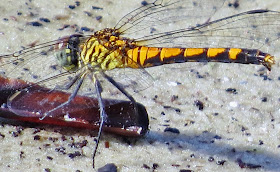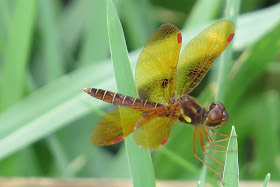 |
| The First-of-the-Season, for me, Piping Plovers have returned to Bunche Beach |
Spent a couple of hours at Bunche Beach Preserve this morning with a dual purpose. First was to look for returning shorebirds and was rewarded with finding nine Piping Plovers are back at Bunche.
Timed my visit for a low tide today and encountered a nice variety of shorebirds. The numbers of returning shorebirds are increasing. Didn't encounter any Red Knots today, but on a visit two weeks was able to spot a few with the Short-billed Dowitchers. Also seen today were Least Sandpipers, Spotted Sandpipers, Yellow-crowned Night-herons, Willets, Semipalmated Plovers, Marbled Godwits, Ruddy Turnstones, Black-bellied Plovers, Wilson's Plovers, lots of White Ibis, Great Blue Herons and Ospreys
 |
| Yellow-crowned Night-Herons |
There were hundreds of small dragonflies, called Seaside Dragonlets, active on the beach. In the past I would have ignored the bugs.
But lately I've joined with so many of by birding friends in the photography and identification of butterflies and dragonflies to fill in the gap during the summer birding doldrums.
 |
| Fish Crow |
 |
| Seaside Dragonlet |
 |
| Also a Seaside Dragonlet |
 |
| Sea Grape |
 |
| Red Tide Advisory posted at Bunche |
The other purpose for my visit today was to see how the Red Tide Event, we are experiencing in Southwest Florida, was effecting this shoreline today. Unlike my visit here on August 2nd, very little evidence of the terrible fish kill could be seen today. There were a few small fish - mullets, sea trout, jacks, catfish. But a large Southern Stingray was seen.
But this was nothing like what I had encountered on the 2nd, when there were hundreds of dead fish stinking up the beach.
It was interesting to identify so many of species seen then The Red Tide fish kill had included mullets, marine catfish, several species of eel, cowfish, flounder, porcupine fish, a nurse shark, groupers including a goliath grouper, speckled sea trout, batfish, pompano and other jacks, spadefish, stingrays, parrotfish, tarpon and other stuff I couldn't identify.
http://www.myfwc.com/research/redtide/
Tons of these fish have been removed from beaches. Sadly very large numbers of sea turtles, including rare Ripley's Turtles have washed ashore. Many couldn't be saved. Other sea life are suffering as well including dolphins and manatees
So what is the cause for these terrible algae blooms in the Gulf, Lake Okeechobee and the Caloosahatchee River. People!!!
The Channelizing of the rivers, the diversion of water away from the Everglades, the Lake O dikes and the nutrient loading of our water sheds by agriculture. But the fertilizers we use to keep our lawns and golf courses so green and lush. And don't forget the contributions from thousands of septic systems.
So what can be done? Well the people aren't going to be going away. But we'll have to pay Billions to undo all the damage to the environment created by former generations in their efforts to 'drain the swamp'.
Turns out we need the swamps. The water that is currently flushed from Lake O through the Caloosahatchee River and the St Lucie Canal must be seriously reduced. And the tainted waters of Lake O must be sent south instead. These waters need to pass through a much larger array of storm water treatment areas, that what already exists today, where the heavy nutrient loads can be filtered out and then sent further south through spreader canals, instead of the straight channels used now. The tainted water entering Lake O, through the Kissimmee River will also need some type of treatment process to reduce its nutrient load contribution. This is all very complex. Restriction on land use, water drainage and fertilization may end up be required. But if the Ice Caps were to melt, all these problems go away.





























